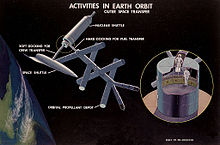Space Transportation System
This article includes a list of general references, but it lacks sufficient corresponding inline citations. (June 2011) |
George Mueller | |
| Purpose | Reusable, low-cost transportation to Earth orbit, cislunar and interplanetary space |
|---|---|
| Status | Failed to gain political support |
| Program history | |
| Launch site(s) | Kennedy Space Center |
| Vehicle information | |
| Uncrewed vehicle(s) | Space tug |
| Crewed vehicle(s) |
|

The Space Transportation System (STS), also known internally to
In February 1969, President Richard Nixon appointed a Space Task Group headed by Vice President Spiro Agnew to recommend human space projects beyond Apollo. The group responded in September with the outline of the STS, and three different program levels of effort culminating with a human Mars landing by 1983 at the earliest, and by the end of the twentieth century at the latest. The system's major components consisted of:
- A permanent space station module designed for 6 to 12 occupants, in a 270-nautical-mile (500 km) low Earth orbit, and as a permanent lunar orbit station. Modules could be combined in Earth orbit to create a 50 to 100 person permanent station.
- A chemically fueled Earth-to-orbit shuttle.
- A chemically fueled space tug to move crew and equipment between Earth orbits as high as geosynchronous orbit, which could be adapted as a lunar orbit-to-surface shuttle.
- A nuclear-powered shuttle or ferry using the NERVA engine, to move crew, spacecraft and supplies between low Earth orbit and lunar orbit, geosynchronous orbit, or to other planets in the solar system. A crew module derived from the space station module would be used to send humans to the Moon or Mars.
The tug and ferry vehicles would be of a modular design, allowing them to be clustered and/or
The STS was championed by NASA Administrator Thomas O. Paine until May 1969 and gained Agnew's enthusiastic support. However, as Apollo accomplished its objective of landing the first humans on the Moon, Nixon realized that political support for further crewed space activities was beginning to wane, and the Congress would be unwilling to provide funding for most of these extended activities. Based on this, Nixon rejected all parts of the program except the Space Shuttle, which inherited the STS name. Nixon accepted Paine's resignation in July 1970 and replaced him as administrator with James C. Fletcher.
As a result of funding constraints, Shuttle was significantly scaled back from its planned degree of reusability. The overall program scheduled was also delayed. The Shuttle first flew in
A second part of the system, Space Station Freedom, was approved in the early 1980s and announced in 1984 by president Ronald Reagan. However, this also became politically unviable by 1993, and was replaced with the International Space Station (ISS), with substantial contribution by Russia. The ISS was completed in 2011.
1969 Space Task Group
This section is empty. You can help by adding to it. (March 2013) |
System vehicles
Earth-to-orbit shuttle

This section needs expansion. You can help by adding to it. (June 2011) |
Space tug


The MSFC space tug was designed to handle a number of missions including satellite repair, transfer to geosynchronous orbit, and as the name implies, towing payloads to the nuclear shuttle. Its modular design was centered around a cylindrical propulsion module, with an attachable crew module, cargo module, and lunar landing legs to convert it to a lunar orbit-to-surface shuttle.
This section needs expansion. You can help by adding to it. (June 2011) |
Nuclear ferry

Planned uses for NERVA included a visit to
Space station module
This section needs expansion. You can help by adding to it. (January 2013) |
Projected program cost
This section is empty. You can help by adding to it. (March 2013) |
References
- ^ Portree, David S.F. (April 18, 2012). "Integrated Program Plan "Maximum Rate" Traffic Model (1970)". Wired.
- ^ Space Task Group Report, "Program Objectives", 4.b.
- ^ a b "Nuclear Rockets: To Mars and Beyond". National Security Science Magazine. Los Alamos National Laboratory. Archived from the original on 2014-10-24.
 This article incorporates text from this source, which is in the public domain.
This article incorporates text from this source, which is in the public domain.
Further reading
- "Report of the Space Task Group, 1969". NASA. Retrieved 6 August 2009.
- Compton, W.D. and Charles D. Benson, NASA SP-4208 Living and Working in Space: A History of Skylab (1983) Chapters 5 and 6 mention 1969 Space Task Group's plan leading to a crewed Mars landing by 2000
- Heppenheimer, T.A. The Space Shuttle Decision: NASA's Search for a Reusable Space Vehicle. Washington, DC: National Aeronautics and Space Administration, 1999.
- Wade, Mark. "Space Tug". Encyclopedia Astronautica. Archived from the original on July 2, 2002. Retrieved June 15, 2011.
- NASA Report, Technical Study for the Use of the Saturn 5, INT-21 and Other Saturn 5 Derivatives to Determine an Optimum Fourth Stage (space tug). Volume 1: Technical Volume, Book 1, Web Address when accessed: https://ntrs.nasa.gov/archive/nasa/casi.ntrs.nasa.gov/19810065609_1981065609.pdf
- Dewar, James. "To The End Of The Solar System: The Story Of The Nuclear Rocket", Apogee, December 2003. ISBN 0813122678
External links
- "Beyond Apollo: Five options for NASA's future (1970)". Archived from the original on 8 October 2011.
- Report of the Space Task Group, 1969
